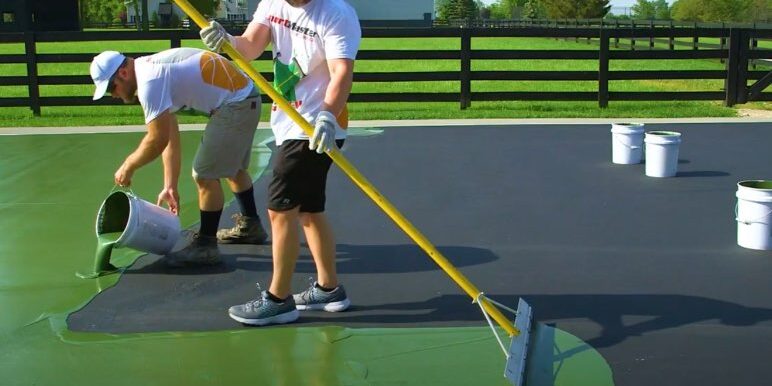Custom Pickleball Court Construction for Residential and Commercial Spaces
Custom Pickleball Court Construction for Residential and Commercial Spaces
Blog Article
Sustainable Practices in Pickleball Court Building And Construction You Should Know
As the appeal of pickleball proceeds to climb, so also does the demand for lasting practices in court construction. The impact of these practices extends much beyond the court itself.
Choosing Eco-Friendly Materials
Choosing eco-friendly products is an important action in the building and construction of lasting pickleball courts. The option of sustainable materials not just minimizes environmental impact however likewise enhances the durability and efficiency of the court. Key products include recycled rubber for the surface, which uses excellent resilience and shock absorption while drawing away waste from landfills.
Additionally, using locally sourced products decreases transportation emissions and sustains regional economies. Pickleball court construction. For example, utilizing indigenous woods for fencing and seating can give a sustainable visual while making certain resilience against the components.
Incorporating permeable products for court structures can further add to sustainability by permitting for all-natural water drain and decreasing drainage. These choices not only protect local environments but likewise advertise healthier play atmospheres.
Efficient Water Drainage Solutions
While the option of green materials is necessary, implementing effective drainage remedies is similarly critical for keeping lasting pickleball courts. Appropriate water drainage not only safeguards the court surface area from water damage yet likewise lessens erosion and overflow, advertising environmental integrity.
Efficient drain systems can include absorptive paving, which enables water to infiltrate the ground as opposed to merging on the surface area. This reduces the probability of standing water, which can bring about mold and various other upkeep issues. Furthermore, including purposefully put drain channels and swales can guide excess water far from the court area, making sure a dry having fun surface and avoiding soil erosion.
Making use of indigenous vegetation in the landscape design around the courts can additionally improve drainage by soaking up excess water and lowering overflow. These plants need much less watering and promote biodiversity, aligning with lasting techniques.
Furthermore, it is critical to consistently keep the drain system to guarantee its lasting effectiveness. This includes clearing up debris and surveillance for clogs. By prioritizing effective drainage solutions, pickleball court producers can considerably add to the sustainability and durability of the center, eventually benefiting both players and the environment.
Energy-Efficient Illumination Options
As the need for pickleball continues to grow, integrating energy-efficient illumination choices into court layout has actually come to be progressively crucial for sustainability. Traditional illumination systems frequently take in extreme power, contributing to higher functional prices and environmental effect. As a result, adopting modern, energy-efficient innovations is necessary for both new constructions and remodellings.
LED (Light Emitting Diode) illumination attracts attention as a leading option due to its durability and energy financial savings (Pickleball court construction). Contrasted to conventional lights, LEDs utilize approximately 75% less energy and can last up to 25 times much longer, considerably minimizing upkeep costs. Moreover, the directional nature of LED illumination lessens light air pollution, making certain that illumination is concentrated on the court as opposed to bordering locations.

Lasting Surface Area Alternatives
Discovering lasting surface area alternatives for pickleball courts has acquired grip among players and building contractors alike. The emphasis on green materials not only aligns with the growing ecological awareness but also improves the efficiency and resilience of the courts.
This material offers excellent shock absorption, reducing the risk of injuries for gamers while advertising sustainability. These tiles are simple to change and install, and their flexibility allows for various court configurations.
Natural yard courts are pop over to this web-site additionally emerging as a sustainable option, promoting biodiversity and lowering the warm island result. However, they need regular maintenance and water, which might not align with all sustainability objectives.

Water Conservation Strategies

One more reliable method entails the installation of rainwater harvesting systems. These systems store and gather rain for use in keeping court surface areas and landscaping. This technique not just preserves drinkable water but likewise minimizes reliance on community resources.
Moreover, employing drought-resistant landscaping around the courts is important. Native plants need less water and are much better adjusted to regional environment conditions, therefore reducing total water consumption. Additionally, using effective watering systems, such as drip irrigation, ensures that water is supplied directly to plant origins, lessening evaporation and waste.
Verdict
Incorporating lasting techniques in pickleball court building and construction significantly adds to ecological preservation and source effectiveness. By focusing on these techniques, the construction of pickleball courts can align with broader ecological goals while promoting longevity and performance within areas.
As the appeal of pickleball proceeds to increase, so as well does the requirement for lasting techniques in court construction.Selecting environment-friendly products is a vital action in the building and construction of lasting pickleball courts. By focusing on energy-efficient lighting options, pickleball court producers can contribute to a much more sustainable future while satisfying the my website demands of players and stakeholders alike.Integrating sustainable surface options not just improves the efficiency of pickleball courts however also paves the way for executing reliable water conservation strategies.Including lasting practices in pickleball court building substantially contributes to ecological preservation and resource performance.
Report this page